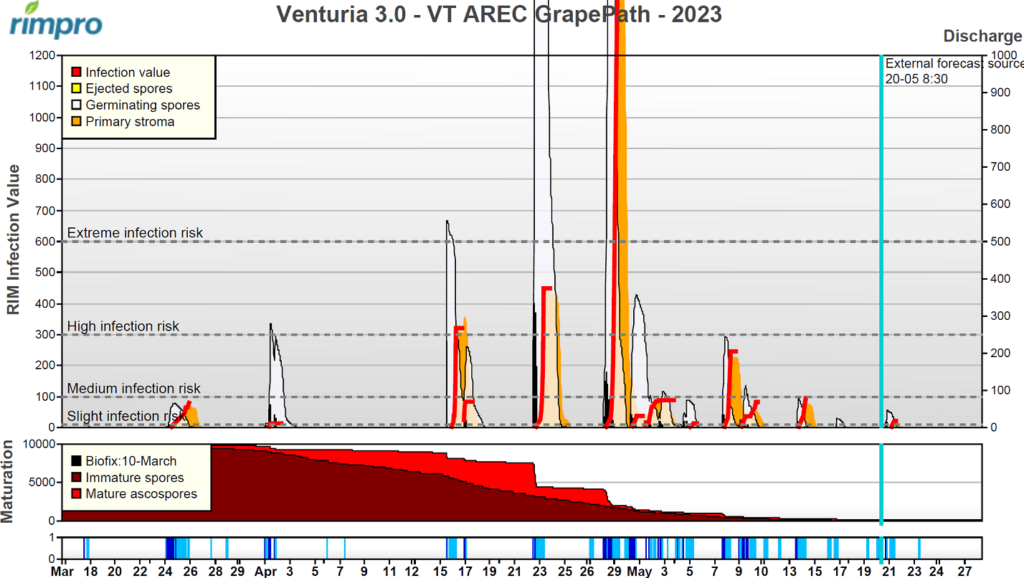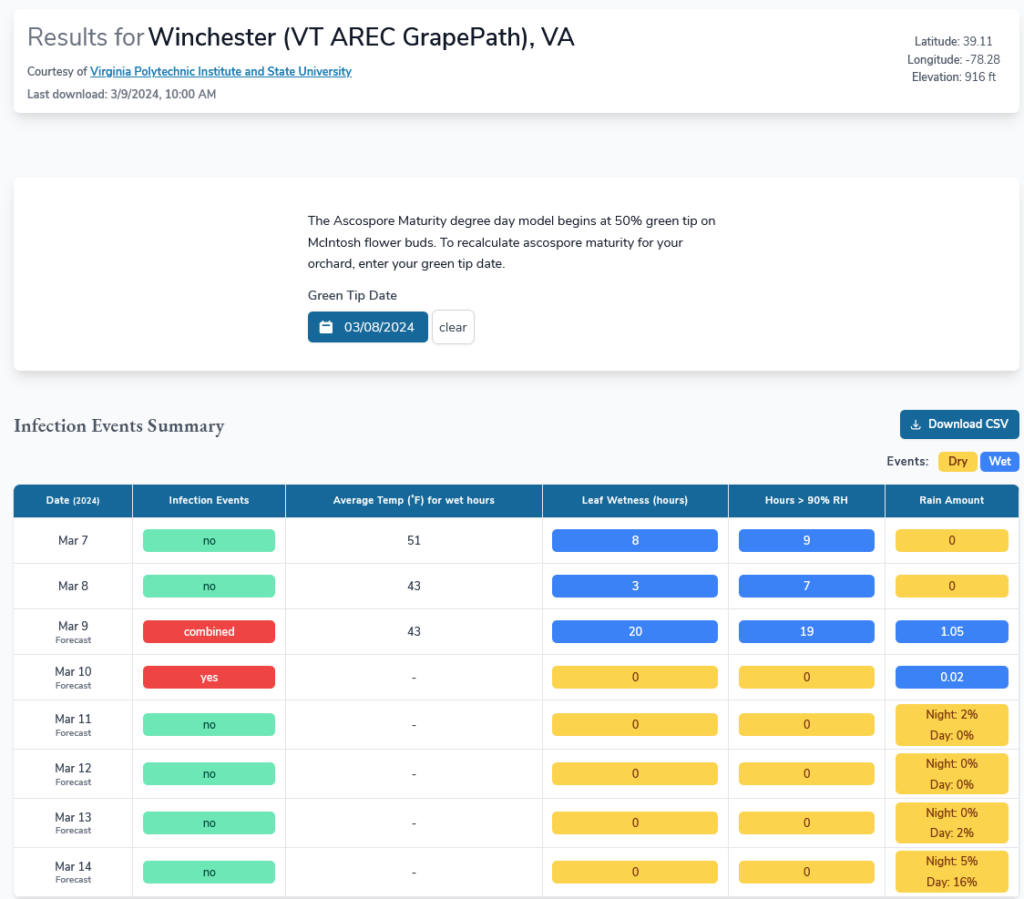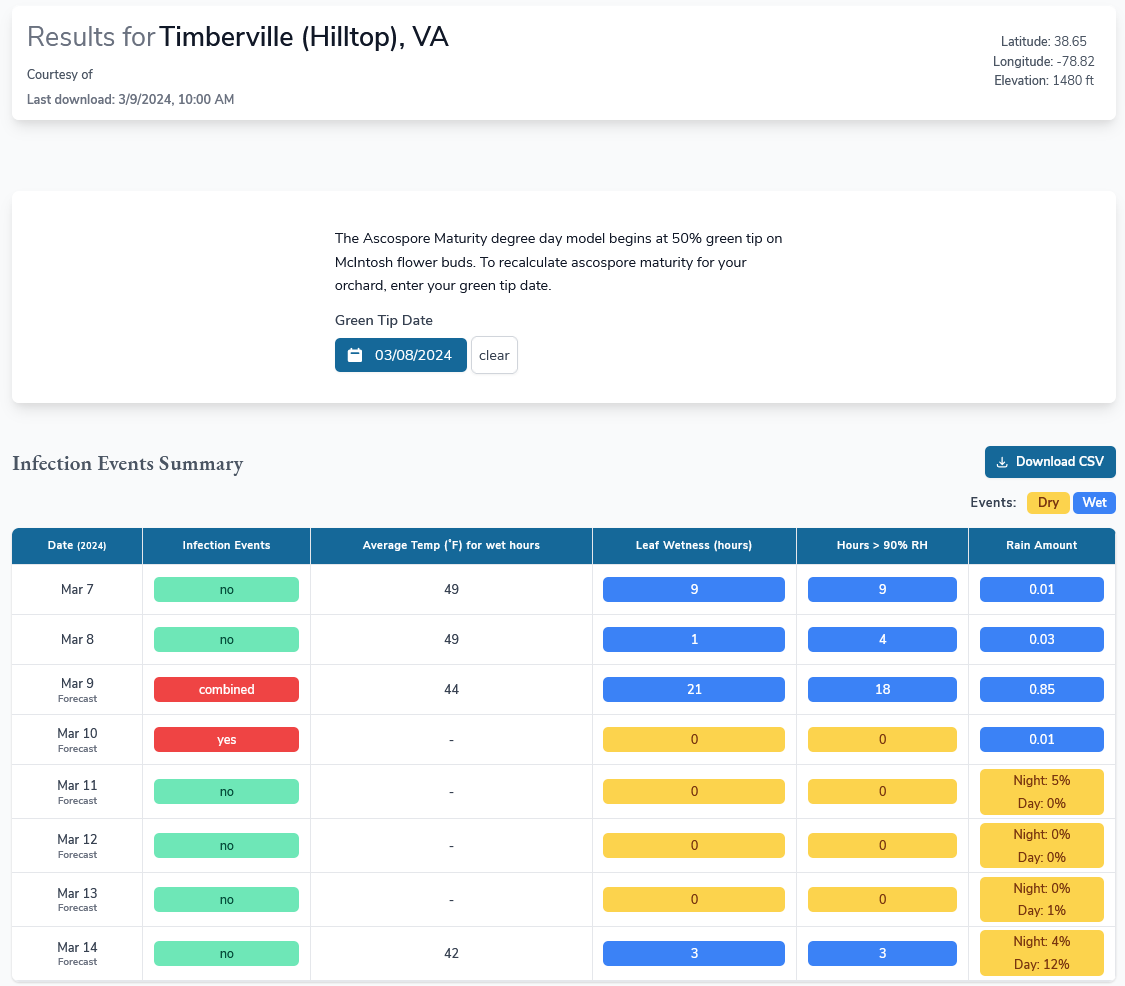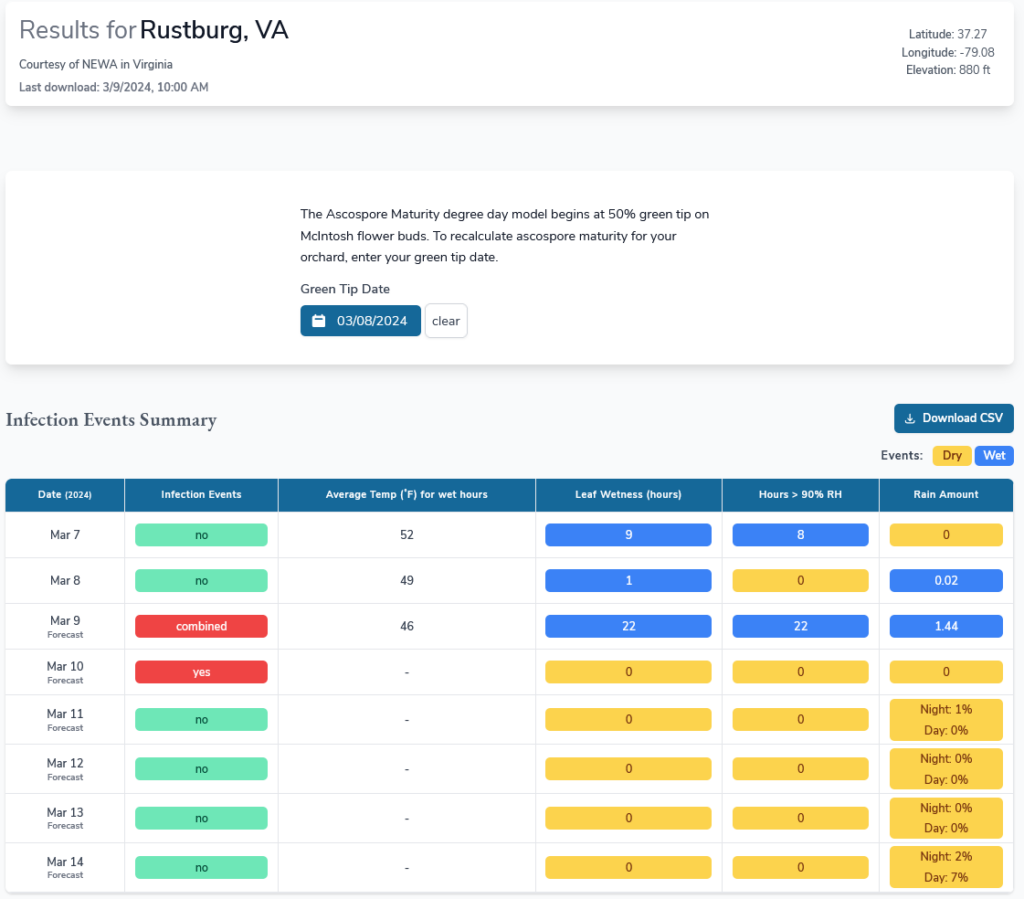2024 Green Tip to Second Cover Fungicide Spray Recommendations and 2023 Apple Scab Infections Retrospective
On March 8, 2024, we recorded 50% Green Tip on ‘Pink Lady’ and ‘Gala’ trees at the VT AHS Jr AREC) in Winchester, VA. In Botetourt county GT was reached on March 9 on Red Delicious while 1/4-inch green was recorded on Gala. In Nelson county on March 9th, Pink Lady was beyond green tip, likely 20-30% in 1/4 inch green, Gala was starting with green tip, so not yet at 50% green tip, while Granny Smith was still at silver tip. We define Green Tip (GT) as the date at which on your earliest apple cultivar of interest, that is susceptible to scab, your trees reach 50% of fruit buds at green tip. This stage is important as we start to think about apple scab infections, which technically can occur on any exposed green tissue if the scab ascoposres in apple leaf litter on the on the orchard floor are mature. The best way to determine if your trees are at green tip is by randomly looking at 100 floral buds (not vegetative or terminal buds) on at least 10 or 15 trees, and tallying up in tabs of five on a piece of paper the buds in dormant, silver tip, and green tip stage categories. If you get 50 out of 100 of all buds you look are at green tip, that is Green Tip stage. The same practice can help you determine if you are at quarter inch green (QIG) for last window to use copper (50% of flower buds at QIG stage). The best way to predict apple scab infection using the weather forecast are the models like NEWA scab model is available here: https://newa.cornell.edu/apple-scab (free) and RIMpro model available here: https://www.rimpro.eu/ (subscription based).
If you had visible scab symptoms on apple leaves and/or fruit in 2023, both early or late in the season, you will need to apply fungicides starting at green tip (GT) and not skip the following applications at 5 to 7 days interval during the following stages: quarter inch green (QIG), half-inch green (HIG), tight cluster (TC), pink bud (PK), bloom (BL), petal fall (PF) and first cover (FC). The reason why is because you are starting the season with a high apple scab fungus spore dose in leaf litter on the orchard floor which means that the carryover infection pressure is high from the previous season. Your copper applied from GT to QIG is equal in efficacy to one mancozeb spray application, so no point in doing both.
In 2023, the first major scab infection was recorded based on the RIMpro’s advanced model on 25 March in Rustburg, 31 March in Tyro (green tip recorded on Granny Smith on 1st March) and 15 April in Winchester (green tip recorded on Fuji in Winchester on 17th March) (Fig. 1), so early scab infections are possible, especially in orchards which has visible scab symptoms last year.

Figure 1. RIMpro apple scab model output for 2023 in Winchester, VA (historical data from a weather station). White camel hump-like areas labelled “Germinating spores” show cumulative number of Venturia inaequalis ascospores that germinate over time and are read using the right-side vertical Y-axis scale that is labelled “Discharge”. The red curved lines are scab infections. Read each red curve’s peak RIM infection value(s) using the vertical Y-axis scale on the left-hand side of the graph labelled “RIM Infection Value”. Peak RIM value divided by 100 gives you the percentage of the total season’s ascospores that will cause infection for a given infection period (wetting event). Orange area labeled “Primary stroma” represents scab lesions that were initiated by infection from germinating spores and that are incubating in the leaf after which scab lesions will become visible. This is worth knowing because if no fungicide was applied before the infection started, some or all of the incubating infections can be eliminated by using fungicides with post-infection activity. The light red area in the middle graph labeled “Maturation” is the proportion of mature ascospores that are ready for discharge with wetting events whereas the dark red area shows the proportion of immature ascospores still remaining in leaf litter on the orchard floor. The dark blue bars in the bottom graph showing wetting and dates, are the actual rain periods. The light blue bars are actual wetting periods when no rain is falling but trees are still wet after rain. Used by permission of RIMpro B.V., France.
In 2024, apple scab RIMpro models for Winchester, VA, have not yet predicted that an infection is possible in near future. We cannot report RIMpro’s call for first scab infection on other locations as the Tyro, VA, and Rustburg, VA, weather station subscriptions were not renewed for 2024 and will not be so we cannot see these model predictions. However, the NEWA’s freely available apple scab model, is reporting that weak scab infections are possible today into tomorrow i.e. 9-10 March in Winchester, Timberville and Rustburg at locations where GT started (NEWA model, Figures 2-4). If you will use only NEWA’s apple scab prediction model, major infection events are when there is >15% ascospore discharge predicted. NEWA scab model is available here: https://newa.cornell.edu/apple-scab
 Figure 2. Output from NEWA apple scab model for 3/9/2024 for Winchester, VA (Source: https://newa.cornell.edu/apple-scab).
Figure 2. Output from NEWA apple scab model for 3/9/2024 for Winchester, VA (Source: https://newa.cornell.edu/apple-scab).
 Figure 3. Output from NEWA apple scab model for 3/9/2024 for Timberville, VA (Source: https://newa.cornell.edu/apple-scab).
Figure 3. Output from NEWA apple scab model for 3/9/2024 for Timberville, VA (Source: https://newa.cornell.edu/apple-scab).

Figure 4. Output from NEWA apple scab model for 3/9/2024 for Rustburg, VA (Source: https://newa.cornell.edu/apple-scab).
In this this period of the year, the delayed dormant copper spray applications are recommended. If you had fire blight in your orchard in last two years, you should apply delayed-dormant copper spray anywhere from Silver to 1/4″ green (QIG) or 1/2″ green (HIG), if label permits HIG use for you copper product of choice. Many formulations limit use to QIG as the latest stage you can apply it to avoid phytotoxicity and russetting of future fruit. Copper can reduce fire blight bacterium inoculum which reaches bark surface from cankers during warm weather in spring in the form of exuded orange ooze of the bacterium or as ooze-less bacterial colonies. Copper will also affect any apple scab overwintering in buds. The usual rate is 6 to 8 lbs of some of the popular products like Cuprofix, COCS, NuCop (fixed coppers, 40 to 50% copper equivalent). However, if you had fire blight last year or heavy rains are predicted in spring, it is wise to use the highest labelled rate of copper for delayed-dormant use, so that some residue lasts on the tree through the rain. If fire blight was not an issue in your or any nearby orchards and you do not have fire blight cankers on your trees, you can apply mancozeb instead of copper. Keep in mind that maximum rate of copper allowed between silver-tip and green-tip stage is that of Basic Copper 53, limited to no more than 11.3 lbs of product/Acre (6.0 lbs copper/A), which might be something you can consider if you had fire blight and/or bitter rot in your orchard last year (if can help with reducing overwintering inoculum).
Mancozeb will reduce scab as well as bitter rot or black/white rot inoculum. Scab and bitter rot inoculum can overwinter under the bud scales. However these rots also overwinter in branch/trunk cankers or in fruit mummies left after thinning in the canopy and on the ground. In some years, copper/mancozeb spray at GT to HIG may not be necessary if the weather conditions are cold, which prevents any small amount of released scab ascospores to establish infections. And RIMpro model can indicate this to you by showing only the white humps that are NOT followed by red curve line that rises above 100 RIM value (see an example in Fig. 1 of ascoposre germination of 1 April 2023, that did not lead to infection). Even though omitting this spray application can save you money, many still apply copper to cover for fire blight, scab inoculum in buds, and for any low infection events before tight cluster.
The next apple scab targeted spray application(s) are best determined by looking at the RIMpro’s apple scab model predictions (Fig. 1) for a significant infection period. In commercial orchards that did not have symptoms of apple scab last year, infection predictions with any red curved line peak at or above 300 RIM value based on the weather forecast, are significant infections. In an example in Figure 1, on 15 April was the first major infection worth applying single-site fungicide in mix with mancozeb.
For the first major scab infection in the spring (usually HIG to TC) my recommendation is to apply anilinopyrimidine (AP) fungicides, either Vangard (3 oz/A), Scala (5 fl oz/A), or Luna Tranquility (12 fl oz/A) in a tank mix with mancozeb (at least 3 lb/A). The AP fungicides work best during cool weather in spring and can be applied before or 72 hr after the time when rain event began and caused scab infection (kick-back activity), however, use this kick-back mode of activity only in an emergency i.e. if you know you did not have any fungicide applied before the infection when you see it in the scab model like RIMpro or NEWA. You can use captan 3 lb/A plus mancozeb 3 lb/A instead, before the rain, keeping in mind that both of those fungicides do NOT have kick-back activity and that captan should not be applied anywhere near a past or planned future oil applications (be cautions as captan uptake can cause tissue injury). Dodine (Syllit) is an option but is limited to two applications before pink bud (PK) and should not be used where resistance to dodine is present (active ingredient of Syllit). Vangard (3 oz/A), Scala (5 fl oz/A), or Luna Tranquility (12 fl oz/A) with mancozeb (3 lb/A) can be applied once more (up to TC) and keep in mind that they are NOT effective against juniper rusts (that is why you are adding mancozeb in a mix, to protect against the rusts). If the weather is cold and the TC stage extends, gaps until PK bud can be filled with mancozeb applied alone (3 lb/A).
However, at Pink Bud, the warm weather will allow severe scab and rust infections that will dictate you to switch to the highly effective DMI fungicides that control both scab and rusts (e.g. Inspire Super, Procure, Cevya, whihc are the best choices for scab and rust). These should also be tank-mixed with mancozeb (3 lb/A). On the other hand, if you had particularly bad powdery mildew last year in the orchard your Luna Tranquility (12 fl oz/A) at TC will be the best choice and should be used instead of Vangard or Scala, as it will control both powdery mildew and scab (it has two components: fluopyram, and pyrimethanil, which is the same active ingredient in Scala). However, at Pink bud, if powdery mildew was a bigger concern than scab you will need to apply one of these: Rally, Sonoma, Rhyme, Topguard, Indar or Procure in a tank mix with mancozeb, which will be great choices and these fungicides will also work well against juniper rusts.
For the next major scab infection predicted by models, i.e. at early bloom and/or full bloom, my recommendation will be to use SDHI fungicides (group 7) i.e. either Aprovia, Fontelis, Sercadis, Miravis or Excalia plus mancozeb (3 lb/A). Due to limitation in use of ANY group 11 fungicides to a total of only 4 applications per year (strobilurins or QoI-s), I would recommend you to NOT use Luna Sensation, Merivon, or Flint Extra for powdery mildew control in spring but to save group the Group 11 fungicides for apple bitter rot control during summer (no you cannot use 4 spray of each of these fungicides per season; you can use 4 applications of any Group 11 fungicide per the whole growing season). The SDHI fungicides I listed above will also be effective for powdery mildew, but are not effective for rust control, and that is why mancozeb is tank-mixed with them. If you must use Aprovia for scab, use either only one Aprovia application for scab or none, and save the rest of the three applications of Aprovia for apple bitter rot later in the summer as it is the only SDHI effective against bitter rot.
At petal fall, I would recommend using Rally, Topguard, Rhyme or Procure plus mancozeb (stop mancozeb at 77 days before harvest for early maturing cultivars, and switch to captan), but if powdery mildew was not an issue last year, you can use Inspire Super plus mancozeb instead which is the best option for scab and rust control. Another tank mix consideration is Fontelis, Sercadis, Miravis or Excalia plus mancozeb for scab and powdery mildew control at the same time. Juniper rusts can have extended infection periods up until 1st or 2nd cover in Virginia, hence if cedars are nearby, extend DMI use until second cover. Warm wet weather at petal fall can allow Botrytis to infect the dying petals and move from petals into sepals where it can remain quiescent until fruit are moved into storage where the Botrytis can cause gray mold storage decay. Using Inspire Super at petal fall and/or first cover is be the best option because it contains cyprodinil, a fungicide that is effective against Botrytis (if Botrytis is not resistant to this fungicide).
Powdery mildew can have an extended infection periods in highly susceptible cultivars until first or second cover in Virginia, so reserving DMI fungicides for use by second cover in these cases is necessary. If powdery mildew was not an issue last year, Inspire Super plus mancozeb would also be my recommendation for the first cover (10 days after petal fall). If mildew was more a priority for you, use Aprovia, Fontelis, Sercadis, Miravis or Excalia plus mancozeb (3 lb/A). Depending on a year, right before or around first cover primary scab season usually ends, and emphasis shifts more to other diseases.
NOTE: If you are interested in learning how to use RIMpro apple scab prediction model, e-mail me at: acimovic@vt.edu. I can help you subscribe and connect a your or closest neighbor’s NEWA weather station to it (you do NOT need to be the owner of a NEWA station to subscribe and use RIMpro, you can use a neighbor’s station close to you). RIMpro is the best prediction model you can use to determine whether or not the early infection from GT to TC will occur or not. This model can save you money in omitting fungicides when they do not need to be applied early in the season. If you did not have visible scab in your orchard last year, you might not need to apply fungicides for low infection severity events which RIMpro can indicate to you. This is the only model that shows you how severe the infection is for each wetting event. If you had visible scab symptoms last year in your orchard, you should spray for predicted, early-season infection events, that are at or above 100 RIM value (red curves on the graph, Fig. 1). Farms that had no visible scab symptoms in the apple orchard last year, should spray only for infection periods with red curved line at 300 RIM values or above.
